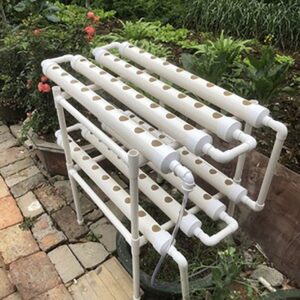Exploring the Benefits of Hydroponic Grow Kits

Looking to enjoy fresh, nutritious greens all year round, without the hassle of traditional gardening methods? Look no further than hydroponic grow kits. With these innovative systems, you can grow a wide variety of greens, from lettuce to herbs, indoors or outdoors, with minimal space and effort.
Hydroponics is a soil-less gardening method that uses nutrient-rich water to grow plants. By providing plants with the perfect balance of water, nutrients, and light, hydroponic systems allow for faster growth and higher yields compared to traditional soil-based gardening.
Not only are hydroponic grow kits easy to set up and use, but they also offer several benefits. First and foremost, they require less water and space compared to conventional gardening, making them an eco-friendly option. Additionally, hydroponic gardening eliminates the need for weeding, tilling, and other labour-intensive tasks, making it ideal for busy individuals or those with limited mobility.
If you’re ready to experience the benefits of hydroponic gardening and enjoy a constant supply of fresh greens, it’s time to explore the variety of hydroponic grow kits available on the market today. Say goodbye to seasonal limitations and hello to year-round gardening bliss!
Benefits of using Hydroponic Grow Kits
Hydroponic grow kits are a great way to grow plants indoors without soil. They have many benefits, such as:
- Saving water and nutrients: Hydroponic systems use less water than traditional gardening, and recycle the nutrient solution, reducing waste and cost.
- Controlling the environment: Hydroponic kits allow you to adjust the temperature, humidity, light, and pH of your plants, giving them optimal conditions for growth and health.
- Preventing pests and diseases: Hydroponic plants are less prone to pests and diseases, since they are not exposed to soil-borne pathogens or insects.
- Increasing yield and quality: Hydroponic plants grow faster and produce more harvests than soil-grown plants, and have higher nutritional value and flavour.
Types of Hydroponic Grow Kits
There are different types of hydroponic grow kits, depending on the method of delivering the nutrient solution to the plant roots. Some of the most common types are:
- Wicks System: The simplest of all the hydroponics systems, requires no power, but can include a pump to aerate the nutrient solution, but it’s not required for the wick system to work.
- Drip systems: These use a pump and a timer to drip the nutrient solution onto the plant roots, which are usually in a growing medium like coco coir or perlite.
- Ebb and flow systems: These use a pump and a timer to flood and drain a tray of plants with the nutrient solution, which is then recycled back to a reservoir.
- Deep water culture systems: These use an air pump and an air stone to oxygenate the nutrient solution, which is constantly in contact with the plant roots, which are suspended in a net pot or a basket.
- Aeroponic systems: These use a pump and a nozzle to spray the nutrient solution as a fine mist onto the plant roots, which are exposed to the air.
- Nutrient film technique systems: These use a pump and a channel to create a thin film of nutrient solution that flows over the plant roots, which are supported by a net or a mat.
Setting up your Hydroponic Grow Kit
Setting up your hydroponic grow kit is easy and fun. You just need to follow these simple steps:
- Choose a suitable location for your kit. It should have access to electricity, water, and ventilation.
- Assemble the components of your kit according to the instructions. You will need a reservoir, a pump, a timer, tubing, net pots, growing medium, and nutrients.
- Fill the reservoir with water and add the nutrients according to the label. Check the pH and adjust it if needed.
- Place the net pots in the holes of the lid of the reservoir and fill them with growing medium. You can use clay pebbles, rockwool, coco coir, or perlite.
- Transplant your seedlings or cuttings into the net pots. Make sure the roots are in contact with the water.
- Plug in the pump and the timer and set them to run for 15 minutes every hour. This will deliver oxygen and nutrients to the roots.
- Monitor your plants daily and check the water level, pH, and nutrient concentration. Change the water every two weeks or when it gets cloudy.
- Enjoy your fresh and healthy harvest!
Choosing the Right Plants for Hydroponic Gardening
Hydroponic gardening is a method of growing plants without soil, using water and nutrients instead. Choosing the right plants for hydroponic gardening can make a big difference in your success and enjoyment. Some plants are more suitable for hydroponic systems than others, depending on factors such as their growth habits, nutrient requirements, and environmental preferences. Here are some tips to help you choose the best plants for your hydroponic garden.
Maintaining and Troubleshooting your Hydroponic Grow Kit
Hydroponic grow kits are a great way to grow plants indoors without soil. However, they require some maintenance and troubleshooting to keep them working well. Here are some tips to help you with your hydroponic system:
- Check the water level and pH regularly. The water level should be enough to cover the roots of the plants, but not too high to drown them. The pH should be between 5.5 and 6.5 for most plants. You can use a pH meter or test strips to measure it.
- Change the nutrient solution every two weeks. The nutrient solution is the water mixed with fertilizer that feeds the plants. Over time, it can get depleted or contaminated by algae, bacteria, or salts. To change it, drain the old solution and refill the reservoir with fresh water and nutrients.
- Clean the system periodically. You should clean the reservoir, pump, tubing, and net pots every month or so to prevent clogging and disease. You can use a mild bleach solution or hydrogen peroxide to disinfect the parts, then rinse them well with water.
- Monitor the plants for signs of stress or disease. If you notice yellowing, wilting, curling, or spotting on the leaves, or pests like aphids or spider mites, you may need to adjust the water, nutrients, pH, or light. You can also use organic sprays or insecticidal soap to treat the pests.
Tips for Successful Hydroponic Gardening
Here are some tips for successful hydroponic gardening:
- Choose the right system for your plants and space. There are different types of hydroponic systems, such as ebb and flow, drip, aeroponic, and deep-water culture. Each one has its own advantages and disadvantages, so do some research before you decide.
- Maintain the optimal pH and nutrient levels for your plants. Different plants have different preferences for pH and nutrient concentrations, so you need to monitor and adjust them regularly. You can use a pH meter and a nutrient solution tester to measure these parameters.
- Provide adequate lighting and ventilation for your plants. Hydroponic plants need artificial or natural light to perform photosynthesis and grow. You can use fluorescent, LED, or HID lights, depending on your budget and space. You also need to ensure good air circulation and temperature control for your plants, as they can be affected by humidity and heat.
- Prevent pests and diseases from harming your plants. Hydroponic plants are less prone to soil-borne pests and diseases, but they can still be attacked by insects, fungi, bacteria, and viruses. You can prevent these problems by keeping your system clean, using sterile tools and equipment, and applying organic or chemical pesticides when needed.
Conclusion: Why Hydroponic Grow Kits are a Game-Changer for Home Gardening.

Hydroponic grow kits are a game-changer for home gardening because they allow you to grow fresh and healthy plants without soil, pesticides, or a lot of space. You can enjoy the benefits of gardening all year round, even if you live in an apartment or have a busy schedule. Hydroponic grow kits are easy to set up, maintain, and harvest. They are also eco-friendly, saving water and reducing waste. With hydroponic grow kits, you can turn your home into a green oasis and enjoy the satisfaction of growing your own food.
